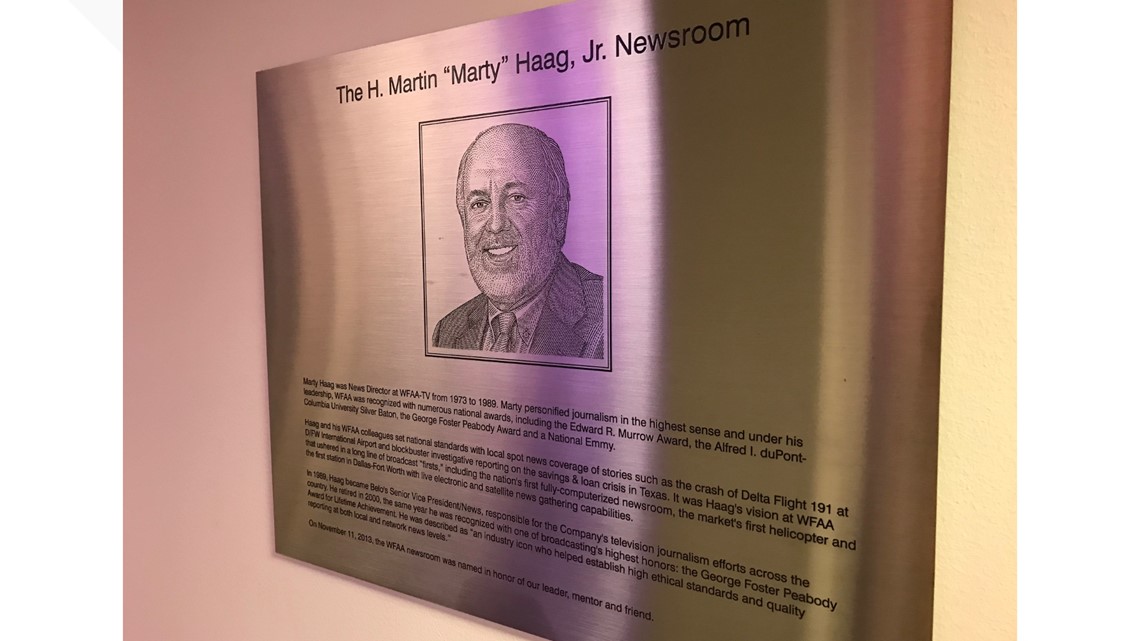DALLAS — They could hardly walk more than a few feet without being greeted by former coworkers or longtime admirers. After all, the WFAA studio on Young Street is where reporters Tracy Rowlett, Byron Harris, Doug Fox and producer John Sparks are revered figures.
The trophy case in the hall is filled with awards they help put there.
“I think all of us have fond memories of this place,” said Rowlett, who was a reporter and anchor at WFAA from 1974 to 1999.
The four men are taking part in an SMU Jones Film Library panel called “Shaping a City” on Thursday night. The library helps preserve the spools of film containing not just WFAA stories from the 60s and 70s but the history of the Dallas-Fort Worth area.
Rowlett, Harris, and Fox all arrived at WFAA together from an Oklahoma City station in 1974 to a city still feeling the pain.
“Still fresh in the mind of people who ran the city had been the Kennedy assassination,” said Rowlett. “Dallas had a terrible time trying to shake that image.”
He believes the emergence and success of the Dallas Cowboys helped, but so to did the news being reported from the city.
“I do believe the emphasis we put on telling good stories and doing journalism the right way helped change an image nationally. Channel 8 became a nationally-recognized station.”
John Sparks worked at WFAA for a combined 19 years and was the producer behind nightly newscasts as well as big stories such as the SMU Football scandal of the 1980s. As the new medium of television became commonplace, it changed how city leaders and stakeholders reached the public.
Accountability was enhanced.
“Television news grew up and the people we covered grew up, too” said Sparks. “The rules started changing, and we held their feet to the fire.”
The role of WFAA and the responsibility that came with the job for Byron Harris he felt was a necessary part of the city’s evolution.
“We thought it was important to a democracy,” Harris said. “We were almost like elected officials in that sense. We thought it was important and that stays with me today.”
The opening of DFW International Airport in 1974 was a huge moment, according to Doug Fox. During his 29 years as a reporter, he saw the image of the area change and slowly shed the stain of JFK’s death.
“DFW Airport was the first time the cities of Dallas and Fort Worth agreed on anything,” Fox said. “Things must have improved enough because by 1984 we had the Republican National Convention right here in Dallas.”
All the men spoke very fondly of former WFAA news director Marty Haag. They say without the support of Haag and other management to tackle contentious stories which sometimes involved advertisers, the success of WFAA and the changes it helped bring about would not be possible.
“Station management learned to trust what we were doing and they backed us,” said Rowlett. “Byron (Harris) was doing cutting-edge stories and if they hadn’t had the commitment to back us legally, I do not know if he could have done it.”
Harris only recently retired in 2016, and said Haag left behind a legacy in broadcast journalism.


“I would just point your attention to the Marty Haag plaque up in the newsroom and remind all my colleagues and all the people who have gone through this newsroom what an important shaping force for journalism he was in this country.”

